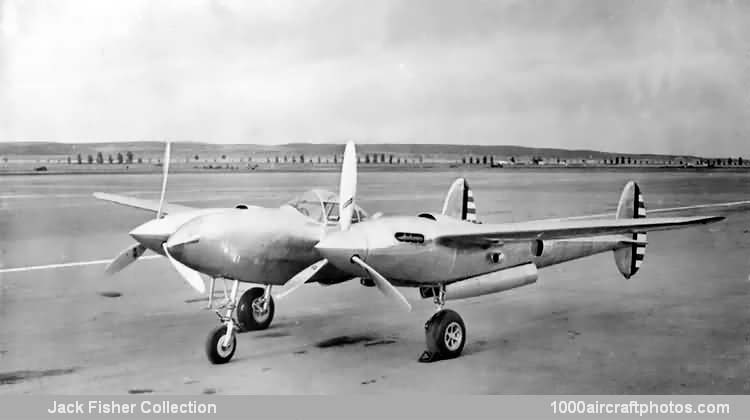The original Lockheed 22 design was drawn to meet an official specification of 1937 for a high-altitude interceptor. The required speed, 360 mph (579 kmh) at 20,000 ft (6,096 m) and 290 mph (467 kmh) at sea level, and the required climb of 6 min to 20,000 ft, led Lockheed to choose a twin-engined layout for what was, in fact, the company's first military project. A twin-boom arrangement was chosen, with 960 hp Allison V-I710-11/15engines, turbo-superchargers, radiator baths and main landing gear units all carried in the booms.
Judged by existing US fighter standards, the Lockheed proposal was radical, not only in its layout, but also for its armament of one 0.9 in (23 mm) and four 0.5 in (12.7 mm) guns in the nose. The gross weight of 14,800 lb (6,713 kg) was greater than that of some contemporary bombers. Nevertheless, the project was accepted by the USAAC on June 23, 1937, and one prototype of the Lockheed 22 was ordered as the XP-38.
The task of detail design went ahead under H.L. Hibbard. Construction started in July 1938, the XP-38 being moved from Burbank to March Field on the last day of the year. Lieutenant B.S. Kelsey made the first flight from March Field on January 27, 1939. Two weeks after the first flight, on February 11, 1939, the XP-38 was delivered across the continent to Mitchell Field, taking 7 hr 2 min with two refueling stops, but it undershot on landing and was destroyed."
Span: 52 ft 0 in (15.85 m)
Length: 37 ft 10 in (11.53 m)
Height: 12 ft 10 in (3.91 m)
Wing area: 328 sq.ft (30.472 sq.m)
Weight empty: 11,507 lb (5,219 kg)
Loaded weight: 13,964 lb (6,334 kg)
Max speed: 413 mph (665 kmh) at 20,000 ft (6,096 m)
Climb: to 20,000 ft (6,096 m) 6 min 30 sec
Service ceiling: 38,000 ft (11,580 m)
Range: 1,390 mls (2,235 km)
